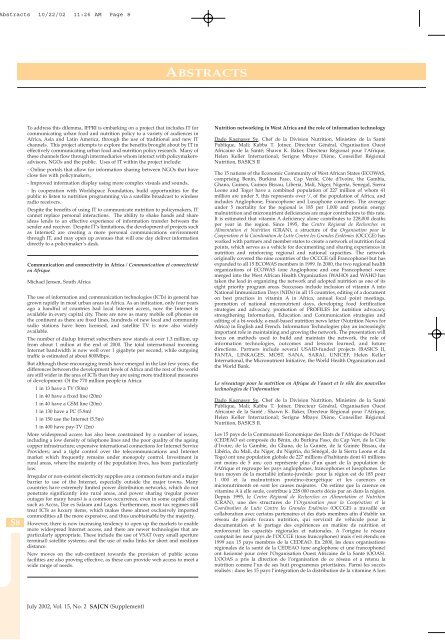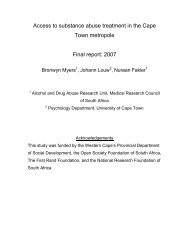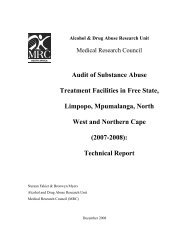Pan-African Conference 21 - 24 July 2002 Inter-Continental Hotel ...
Pan-African Conference 21 - 24 July 2002 Inter-Continental Hotel ...
Pan-African Conference 21 - 24 July 2002 Inter-Continental Hotel ...
Create successful ePaper yourself
Turn your PDF publications into a flip-book with our unique Google optimized e-Paper software.
Abstracts 10/22/02 11:26 AM Page 8<br />
S8<br />
To address this dilemma, IFPRI is embarking on a project that includes IT for<br />
communicating urban food and nutrition policy to a variety of audiences in<br />
Africa, Asia and Latin America, through the use of traditional and new IT<br />
channels. This project attempts to explore the benefits brought about by IT in<br />
effectively communicating urban food and nutrition policy research. Many of<br />
these channels flow through intermediaries whom interact with policymakersadvisors,<br />
NGOs and the public. Uses of IT within the project include:<br />
- Online portals that allow for information sharing between NGOs that have<br />
close ties with policymakers,<br />
- Improved information display using more complex visuals and sounds,<br />
- In cooperation with Worldspace Foundation, build opportunities for the<br />
public to listen to nutrition programming via a satellite broadcast to wireless<br />
radio receivers.<br />
Despite the benefits of using IT to communicate nutrition to policymakers, IT<br />
cannot replace personal interactions. The ability to shake hands and share<br />
ideas lends to an effective experience of information transfer between the<br />
sender and receiver. Despite IT’s limitations, the development of projects such<br />
as <strong>Inter</strong>net2 are creating a more personal communications environment<br />
through IT, and may open up avenues that will one day deliver information<br />
directly to a policymaker’s desk.<br />
Communication and connectivity in Africa / Communication et connectivité<br />
en Afrique<br />
Michael Jensen, South Africa<br />
The use of information and communication technologies (ICTs) in general has<br />
grown rapidly in most urban areas in Africa. As an indication, only four years<br />
ago a handful of countries had local <strong>Inter</strong>net access, now the <strong>Inter</strong>net is<br />
available in every capital city. There are now as many mobile cell phones on<br />
the continent as there are fixed lines, hundreds of new local and community<br />
radio stations have been licensed, and satellite TV is now also widely<br />
available.<br />
The number of dialup <strong>Inter</strong>net subscribers now stands at over 1.3 million, up<br />
from about 1 milion at the end of 2000. The total international incoming<br />
<strong>Inter</strong>net bandwidth is now well over 1 gigabyte per second, while outgoing<br />
traffic is estimated at about 800Mbps.<br />
But although these encouraging trends have emerged in the last few years, the<br />
differences between the development levels of Africa and the rest of the world<br />
are still wider in the area of ICTs than they are using more traditional measures<br />
of development: Of the 770 million people in Africa:<br />
1 in 13 have a TV (50m)<br />
1 in 40 have a fixed line (20m)<br />
1 in 40 have a GSM line (20m)<br />
1 in 130 have a PC (5.9m)<br />
1 in 150 use the <strong>Inter</strong>net (5.5m)<br />
1 in 400 have pay-TV (2m)<br />
More widespread access has also been constrained by a number of issues,<br />
including a low density of telephone lines and the poor quality of the ageing<br />
copper infrastructure; expensive international connections for <strong>Inter</strong>net Service<br />
Providers; and a tight control over the telecommunications and <strong>Inter</strong>net<br />
market which frequently remains under monopoly control. Investment in<br />
rural areas, where the majority of the population lives, has been particularly<br />
low.<br />
Irregular or non-existent electricity supplies are a common feature and a major<br />
barrier to use of the <strong>Inter</strong>net, especially outside the major towns. Many<br />
countries have extremely limited power distribution networks, which do not<br />
penetrate significantly into rural areas, and power sharing (regular power<br />
outages for many hours) is a common occurrence, even in some capital cities<br />
such as Accra, Dar es Salaam and Lagos. Furthermore, most tax regimes still<br />
treat ICTs as luxury items, which makes these almost exclusively imported<br />
commodities all the more expensive, and thus unobtainable by the majority.<br />
However, there is now increasing tendency to open up the markets to enable<br />
more widespread <strong>Inter</strong>net access, and there are newer technologies that are<br />
particularly appropriate. These include the use of VSAT (very small aperture<br />
terminal) satellite systems; and the use of radio links for short and medium<br />
distance.<br />
New moves on the sub-continent towards the provision of public access<br />
facilities are also proving effective, as these can provide web access to meet a<br />
wide range of needs.<br />
<strong>July</strong> <strong>2002</strong>, Vol. 15, No. 2 SAJCN (Supplement)<br />
ABSTRACTS<br />
Nutrition networking in West Africa and the role of information technology<br />
Dado Kagnassy Sy, Chef de la Division Nutrition, Ministère de la Santé<br />
Publique, Mali; Kabba T. Joiner, Directeur Général, Organisation Ouest<br />
Africaine de la Santé; Shawn K. Baker, Directeur Régional pour l’Afrique,<br />
Helen Keller <strong>Inter</strong>national; Serigne Mbaye Diène, Conseiller Régional<br />
Nutrition, BASICS II<br />
The 15 nations of the Economic Community of West <strong>African</strong> States (ECOWAS,<br />
comprising Benin, Burkina Faso, Cap Verde, Côte d’Ivoire, the Gambia,<br />
Ghana, Guinea, Guinea Bissau, Liberia, Mali, Niger, Nigeria, Senegal, Sierra<br />
Leone and Togo) have a combined population of 227 million of whom 41<br />
million are under 5, this represents over 1 / 4 of the population of Africa, and<br />
includes Anglophone, Francophone and Lusophone countries. The average<br />
under 5 mortality for the regional is 185 per 1,000 and protein energy<br />
malnutrition and micronutrient deficiencies are major contributors to this rate.<br />
It is estimated that vitamin A deficiency alone contributes to 228,000 deaths<br />
per year in the region. Since 1995, the Centre Régional de Recherches en<br />
Alimentation et Nutrition (CRAN), a structure of the Organisation pour la<br />
Cooperation et la Coordination de Lutte Contre les Grandes Endémies (OCCGE) has<br />
worked with partners and member states to create a network of nutrition focal<br />
points, which serves as a vehicle for documenting and sharing experiences in<br />
nutrition and reinforcing regional and national capacities. The network<br />
originally covered the nine countries of the OCCGE (all Francophone) but has<br />
expanded to all 15 ECOWAS members in 1999. In 2000, the two regional health<br />
organizations of ECOWAS (one Anglophone and one Francophone) were<br />
merged into the West <strong>African</strong> Health Organization (WAHO) and WAHO has<br />
taken the lead in organizing the network and adopted nutrition as one of its<br />
eight priority program areas. Successes include inclusion of vitamin A into<br />
National Immunization Days (NIDs) in all 15 countries, editing of a document<br />
on best practices in vitamin A in Africa, annual focal point meetings,<br />
promotion of national micronutrient days, developing food fortification<br />
strategies and advocacy, promotion of PROFILES for nutrition advocacy,<br />
strengthening Information, Education and Communication strategies and<br />
editing of a bi-weekly, e-mail-based nutrition news letter (Nutrition News for<br />
Africa) in English and French. Information Technologies play an increasingly<br />
important role in maintaining and growing the network. The presentation will<br />
focus on methods used to build and maintain the network, the role of<br />
information technologies, outcomes and lessons learned, and future<br />
directions. Partners include several USAID-funded projects (BASICS II,<br />
FANTA, LINKAGES, MOST, SANA, SARA), UNICEF, Helen Keller<br />
<strong>Inter</strong>national, the Micronutrient Initiative, the World Health Organization and<br />
the World Bank.<br />
Le réseautage pour la nutrition en Afrique de l’ouest et le rôle des nouvelles<br />
technologies de l’information<br />
Dado Kagnassy Sy, Chef de la Division Nutrition, Ministère de la Santé<br />
Publique, Mali; Kabba T. Joiner, Directeur Général, Organisation Ouest<br />
Africaine de la Santé ; Shawn K. Baker, Directeur Régional pour l’Afrique,<br />
Helen Keller <strong>Inter</strong>national; Serigne Mbaye Diène, Conseiller Régional<br />
Nutrition, BASICS II.<br />
Les 15 pays de la Communauté Economique des Etats de l’Afrique de l’Ouest<br />
(CEDEAO est composée du Bénin, du Burkina Faso, du Cap Vert, de la Côte<br />
d’Ivoire, de la Gambie, du Ghana, de la Guinée, de la Guinée Bissau, du<br />
Libéria, du Mali, du Niger, du Nigéria, du Sénégal, de la Sierra Leone et du<br />
Togo) ont une population globale de 227 millions d’habitants dont 41 millions<br />
ont moins de 5 ans; ceci représente plus d’un quart de la population de<br />
l’Afrique et regroupe les pays anglophones, francophones et lusophones. Le<br />
taux moyen de la mortalité infanto-juvénile pour la région est de 185 pour<br />
1 000 et la malnutrition protéino-énergétique et les carences en<br />
micronutriments en sont les causes majeures. On estime que la carence en<br />
vitamine A à elle seule, contribue à 228 000 morts décès par an dans la région.<br />
Depuis 1995, le Centre Régional de Recherches en Alimentation et Nutrition<br />
(CRAN), une des structures de l’Organisation pour la Coopération et la<br />
Coordination de Lutte Contre les Grandes Endémies (OCCGE) a travaillé en<br />
collaboration avec certains partenaires et des états membres afin d’établir un<br />
réseau de points focaux nutrition, qui servirait de véhicule pour la<br />
documentation et le partage des expériences en matière de nutrition et<br />
renforcerait les capacités régionales et nationales. A l’origine le réseau<br />
comptait les neuf pays de l’OCCGE (tous francophones) mais s’est étendu en<br />
1999 aux 15 pays membres de la CEDEAO. En 2000, les deux organisations<br />
régionales de la santé de la CEDEAO (une anglophone et une francophone)<br />
ont fusionné pour créer l’Organisation Ouest Africaine de la Santé (OOAS).<br />
L’OOAS a pris la direction de l’organisation de ce réseau et a retenu la<br />
nutrition comme l’un de ses huit programmes prioritaires. Parmi les succès<br />
réalisés : dans les 15 pays l’intégration de la distribution de la vitamine A lors

















